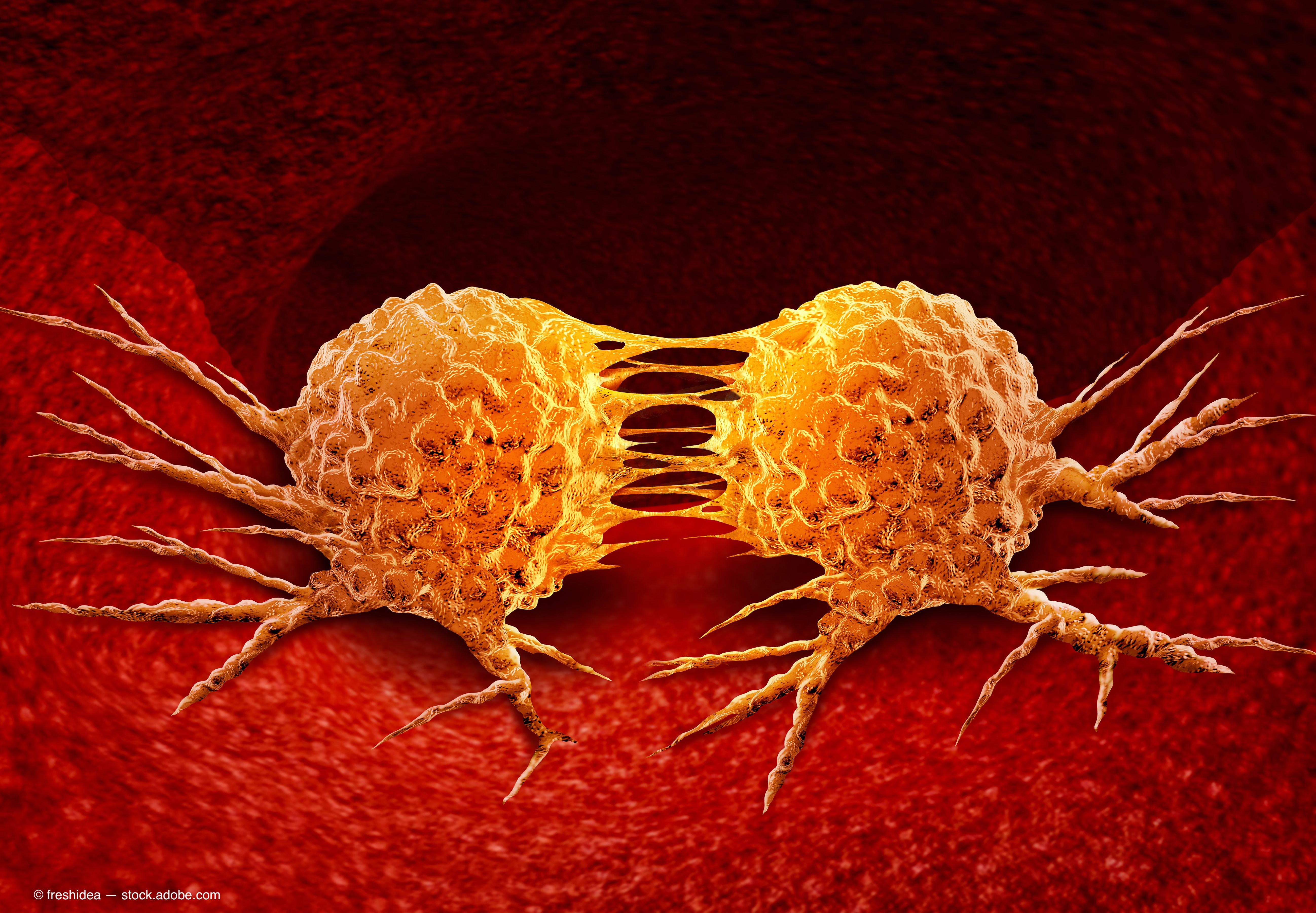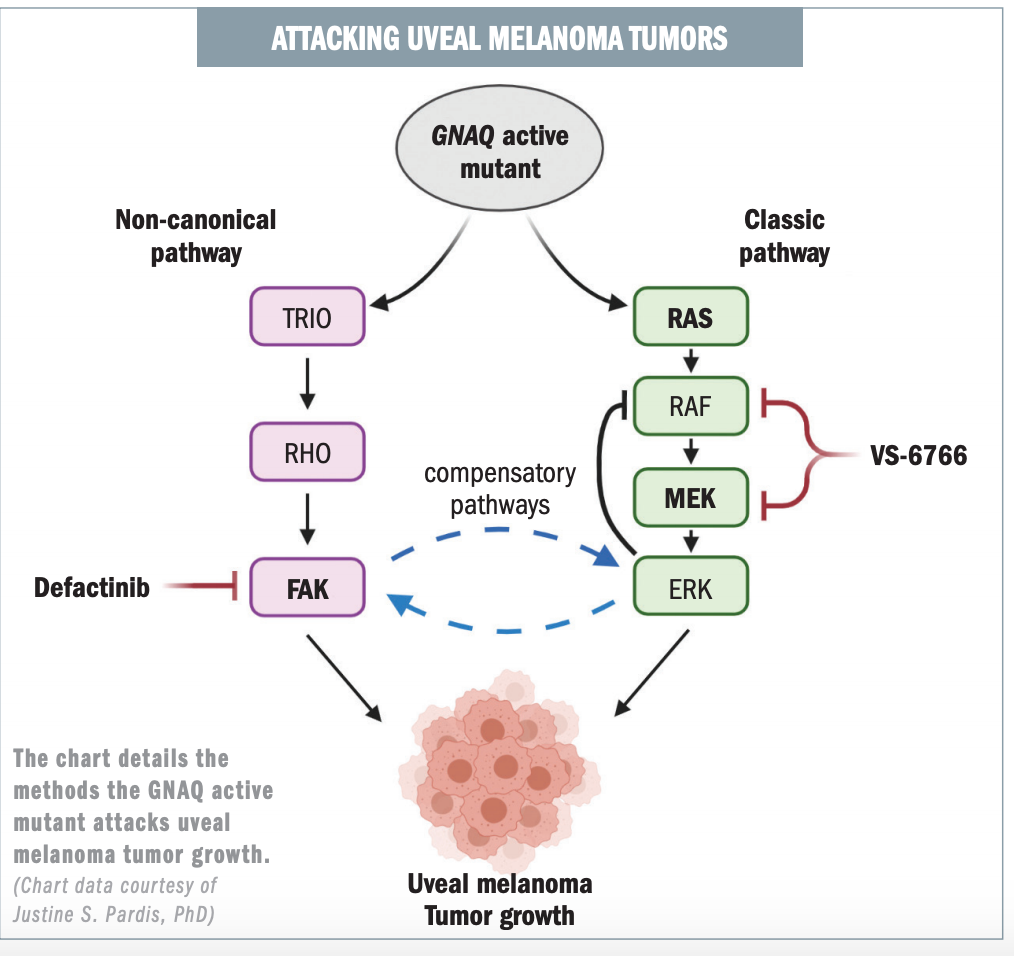Publication
Article
Digital Edition
Options give 1-2 punch to metastatic uveal melanoma
Author(s):
Combining RAF/MEK signaling pathway inhibitor with FAK inhibitor raises bar

This article was reviewed by Justine S. Paradis, PhD
The results of a preclinical study indicate there is hope for an effective treatment for the GNAQ-driven metastatic uveal melanoma, an aggressive form of the disease.
The treatment relies on 2 components, the MEK inhibitor trametinib or the second generation RAF/MEK inhibitor VS-6766 (Verastem Oncology) combined with defactinib, a focal adhesion kinase (FAK) inhibitor (Verastem Oncology), that work better together than apart for controlling uveal melanoma.
Related: Light-activated agent novel option for uveal melanoma
The importance of this potential treatment is underscored by the fact that uveal melanoma is the most frequently occurring ocular cancer in adults, and it becomes metastatic in 50% of patients in whom it develops. The survival rate currently is 2 years, with only 8% surviving following metastasis to the liver.
“To date there is no effective treatment for metastatic uveal melanoma, and there is an urgent need to identify novel precision therapies for advanced and metastatic uveal melanoma patients,” according to Justine S. Paradis, PhD, a postdoctoral fellow at the Moores Cancer Center at the University of California San Diego.

How the treatment works
Trametinib is an inhibitor of MEK kinase activity, and VS-6766 is a second-generation RAF/MEK inhibitor blocking both the MEK kinase activity and the ability of RAF to phosphorylate MEK.
The investigators explained that VS-6766 blocks MEK signaling without the compensatory activation of MEK, which differs from how other inhibitors work.
Defactinib (VS-6063) is an oral small-molecule inhibitor of FAK and PYK2 that is being evaluated as a potential combination therapy for various solid tumors.
Related: Pearls for managing care of high-risk uveal melanoma patients
The combination of the 2 inhibitors induces apoptosis of the uveal melanoma cells, which in turn leads to rapid tumor regression in the uveal melanoma xenografts. When the 2 agents were used alone, the tumor growth was inhibited, but the size of the tumors did not shrink.
In addition, this combination approach also decreased the tumor burden in models of uveal melanoma liver metastasis.
The investigators described that FAK and MEK inhibition combined showed “synergistic cytotoxic effects” in metastatic uveal melanoma cells.
What they did
The investigators used the combination of the MEK and FAK inhibitors in a xenograft mouse model in which the animals were treated for 20 days and found that the tumor volume decreased when the 2 were used together.
In contrast, when used alone, the inhibitors only stabilized the tumor size, with a limited apoptotic response.
Related: Conjunctival melanoma: Unlocking mysteries of disease
In a mouse model of liver metastasis, in which the animals were treated for 21 days, the investigators reported that the metastatic burden in the animals was reduced. The combination of the 2, they reported, very importantly “nearly eliminated all metastatic lesions.”
The team is evaluating residual disease and tumor burden progression after the treatments were stopped.
J. Silvio Gutkind, PhD, distinguished professor of pharmacology and associate director for Basic Science at Moores Cancer Center at the University of California San Diego, and senior investigator of the study, said results should lead to human trials.
“The study identified and reinforced FAK as a viable pathway to inhibit downstream from the GNAQ pathway, which is constitutively active in uveal melanoma,” he said. “We observed that cotargeting of FAK and RAF/MEK signaling led to tumor collapse in uveal melanoma xenograft and liver metastasis models in vivo.”
Related: Liquid biopsies: Not yet ready for prime time in uveal melanoma
Pharmacological inhibition of FAK and MEK inhibited the growth of uveal melanoma cells and had cytotoxic effects leading to tumor collapse in uveal melanoma xenograft and liver metastasis models in vivo.
The results emphasized the importance of cotargeting with FAK and RAF/MEK to provide a new network-based precision therapeutic strategy.
The signal-transduction-based precision therapy data support clinical testing of the combination inhibition in metastatic uveal melanoma.
VS-6766 and defactinib are also being studied clinically to treat low-grade serous ovarian and KRAS mutant non–small cell lung cancers and colorectal cancer.
A phase 2 study of VS-6766 and defactinib in uveal melanoma is expected to commence in late 2020.
Justine S. Paradis, PhD
e:jparadis@ucsd.edu
Paradis has no financial interest in this subject matter.

Newsletter
Don’t miss out—get Ophthalmology Times updates on the latest clinical advancements and expert interviews, straight to your inbox.




